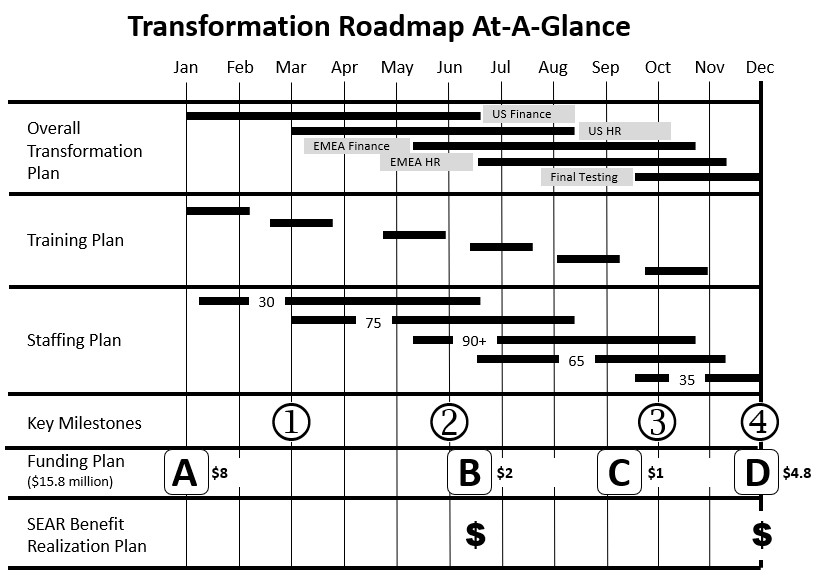Any significant digital transformation is going to take time and is going to be expensive. You’ll be expected to make a formal proposal to explain your request and confirm for the executives (or board members) that your request is thoughtful and sound, and that you have done thorough due diligence to provide the best recommendation from a sea of competing choices.
Here are four recommended components that will keep you focused, organized and thorough. These four components are:
- A single, one-page executive summary;
- A single swim lane graphic – PPT slide – showing basic timelines of key activities;
- A brief, bulleted set of slides covering the high spots of the most important topics (no more the 10 slides);
- A detailed and comprehensive appendix representing all your workpapers from your previous due diligence. This section might contain over 100 slides. Spoiler alert: This section rarely gets presented during the executive presentation.
Before you create your first slide, think of the questions your executive approvers are likely to ask. Here are five sample questions that are frequently voiced when presenting board-level proposals for funding:
- What business problem are you addressing that requires such a significant investment of time and money?
- Have you validated your hypothesis – that this business problem exists and is as urgent as you suggest – with others (particularly others whose opinion on which executives rely)?
- Can you provide supporting evidence that solving this business problem benefits the company beyond its proposed costs?
- Have you considered alternative solutions that deliver similar benefits but at a reduced cost or shorter time horizon?
- Why must we act now? What is the harm in deferring this decision for another quarter or two?
Our goal is to answer those questions and receive executive approval to proceed.
When constructing your presentation and corresponding proposal to executives, it must be comprehensive and thorough and at the same time succinct and crisp. A contradiction of terms? Not at all. Let me explain.
In my August 2022 article I stressed the importance of thoroughly documenting your current state. Such due diligence often generates pages and pages of diagrams of multiple enterprise applications, interfaces, integrations and many manual workarounds. All these activities require a plan for the future as you transform into your desired future state.
Start by creating the most detailed content first and then work your way to the most summarized content. The first – and most tedious – component is your comprehensive appendix. It is important to have everything in this appendix that explains the complexity, inefficiency and ineffectiveness of your current state. This also lays out your detailed roadmap to your desired future state. Due to the size of the appendix, consider including a Table of Contents at the start of the appendix to make searching easier.
Once the appendix is done, sit back and evaluate the content. Ask yourself, “What are the 5-8 most important points on which to focus the presentation?” Yes, the goal is to limit the body of the executive PowerPoint deck to ten slides (these eight slides plus a swim lane graphic – shown below – and an executive summary). What are the executives most likely to want to drill into? For additional input, consider sharing your drafts with an internal ally, possibly your boss or a like-minded member of the executive team. Such a person can guide you to ensure you address the most important points likely to interest the approvers.
Among these critical slides might be a complex graphic showing the complexity and challenge of your current state architecture. Or it could be a slide that includes quotes from your key executives regarding their frustration with accessing data that is spread across multiple enterprise applications. You might include a slide that highlights the financial and operational benefits that the transformation will deliver to the business. There is no single answer for which slides you choose. The key issue is that by keeping this presentation to ten slides, you will likely hold your executive’s attention for the duration of your presentation. And let’s be clear, executives are busy and are not going to sit through a presentation with hundreds of slides. They expect you to do the work of summarizing your recommendation in a board-ready package.
Now, here’s the good news. If you choose the eight most impactful slides, those eight slides, combined with the swim lane and executive summary slides, will generate a lively and productive discussion. This is the goal: to get the executives engaged and move them to a decision point.
Now for the two most impactful slides, starting with the swim lane slide. See the image below.

Creating this slide is only possible after you have created all the content for the appendix. This single slide answers so many executive questions, all on a single visual. Understand that you may choose to include different swim lanes than I have here. The point to takeaway is that the entire project is summarized in a single graphic.
Starting at the top, the Overall Transformation Plan shows when key activities start and end. Most significantly it shows when the overall project starts and ends. The Training Plan shows when you will need key people available to attend training and how long each training topic will last. The Staffing Plan shows when you plan to add external consultants, how many you need by project phase and when each batch of consultants can roll off your project.
Key Milestones show when you expect to deliver specific project deliverables. The Funding Plan shows when you need specific releases of funds and how much. And finally, the SEAR Benefit Realization Plan shows when the company will realize measurable financial benefits. (To review, the SEAR Imperative states that every project must show how it favorably impacts Sales, Expenses, Assets and Risks). That’s it. One page that shows, at a high level, every key topic and date for your transformation initiative. Now then, when an executive asks for more detail on any individual swim lane, the assumption is that you have that supporting detail in your appendix and you can turn to the appropriate page(s) to explain further.
Finally, it’s time to draft your executive summary. The executive summary summarizes the entire proposal on a single page. An example executive summary is as follows:
- We’re losing sales and our costs are soaring due to numerous outdated and inefficient processes.
- We are launching a digital transformation program that will reduce complexity, redundancy and inefficiency enabling us to reduce costs and provide a world-class customer experience.
- This initiative will deliver $70 million in benefits over three years at a cost of $15.8 million.
- This program will be fully operational across all divisions in 24 months.
Now you have a board-ready executive presentation. Ten slides. Page one is your concise executive summary. Page two is your swim lane graphic. Pages 3-10 are the most significant points you want to call out for emphasis. These ten slides should be the right ones to answer executives’ questions and arm them to make a decision. And finally, you have your comprehensive appendix with all your workpapers and due diligence research. The reason that this is so effective is that you are guiding the presentation while enabling your executives to direct the conversation. The executives might wish to spend 30 minutes on the executive summary and the swim lane slides alone. Assuming they are the ones talking and asking questions, that is an excellent outcome. It shows that the executives are engaged and want more information, information that you can provide from your vast appendix slides. It also shows that you applied the effort to summarize the points you wanted to emphasize while simultaneously demonstrating that you have done all the background research and verification that gives the executives comfort that your proposal is thorough.
| Related article: |

Written by Jim Maholic
Jim Maholic has over 25 years of experience as an IT strategist. His career has included two stints as a CIO, executive positions with Big Four and regional consulting firms, and leadership roles with enterprise software companies. He is an award-winning, bestselling author, having written IT Strategy and Business Cases that Mean Business.



